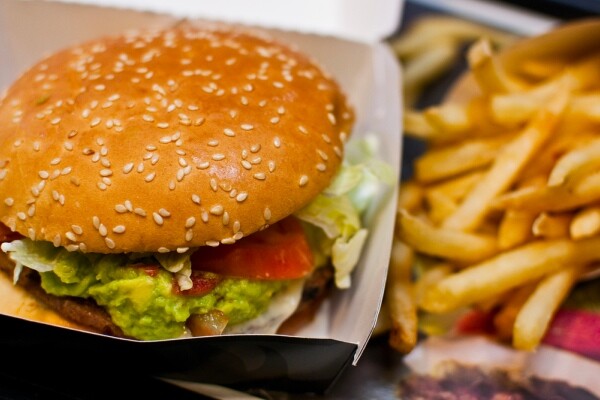We Have a Body Weight Bias When Someone Promotes Healthy Food

What we consider "healthy" is a moving target. We have a vague idea in our heads that something green is healthy, while something like the burger and fries pictured above is not. But "healthy" and "unhealthy" are pretty broad categories that don't mean a whole lot. And that's where we get into some trouble.
Look again at the picture of the burger and fries above. We know that's not healthy. But how unhealthy we believe it is depends entirely on the packaging and who's promoting it. If the photo shows up on social media by someone who is "of normal weight," we believe the burger and fries is healthier than if the same photo if posted by someone obese. And this sort of prejudice happens more often than you think.
This insight comes courtesy of a pair of experiments by Cornell researchers. In the first, participants were given photos of food (examples included "chopped salad with croutons" and "sliced beef with vegetables"), along with the photo of a blogger that supposedly posted the photo. They were then asked how healthy the food was on a scale of one to seven. The only variable, then, was the blogger's photos. When they crunched the numbers, researchers found that people felt meals were less healthy if the meal was presented by an overweight blogger.
In the second study, researchers upped the ante by providing fat and calorie content information of the meal. And yet, even in those cases, participants considered the food presented by the thinner blogger "healthier." Which is to say that having facts in front of someone is less important than simply the person behind the photograph.
What's happening here?
"We thought that widely held stereotypes about heavier people -- for example, that they lack self-control and eat rich, fattening foods -- would color perceptions of the food itself in similar ways," wrote Dr. Jonathon Schuldt, assistant professor and lead author of the study, in an email. "Our results supported that hypothesis."
Humans are governed by stereotypes that are built, in large part, on simple visual aesthetics. These visual cues are hard-wired into our brains as a way for us to take shortcuts in our everyday decision-making processes. Sometimes, this works just fine. (Say, seeing a sick-looking guy blowing his nose and purposefully taking a wide berth.) Sometimes, these shortcuts end up leading us off a cliff. (Say, a lot of racism and sexism.) But, particularly nowadays, there's an added problem mucking up these shortcuts: ad agencies and brand marketers taking advantage of us.
Over the last five years or so, the entire landscape of how we get exposed to food has completely changed. Rather than the culture of "food celebrity" being the exclusive terrain of television and cookbooks, now everyone with a camera and a little gumption can start an Instagram account.
This is how a lot of us are figuring out what to eat, what to cook, what's healthy, and what's not. "With the rise of social media, more and more people are logging into social networking sites and food blogs when searching for information about healthy eating," Schuldt wrote. The biggest problem with that is we tend to believe the information depending on the author's body type.
Mind you: This doesn't mean old-school food TV is immune to this effect either. "Our results suggest that audiences of food-related programming may indeed come to different conclusions about whether a recipe or dish is healthy depending on the body weight of the food celebrity or chef," Schuldt said. "Media coverage of weight loss by food celebrities including Paula Deen and Adam Richman may reflect society's fascination with these personalities and what their body weight signals about the kinds of food they enjoy and recommend to others."
So, where does that leave us? How do we fix this faulty wiring that allows visuals to trick us into making bad decisions? Coming up with a legitimate answer to that question, of course, is an act of futility. (Unless you know how to undo eons of evolution.) Rather, the most important takeaway from the study is simple awareness to this fact. We're tricking ourselves whenever we see images of food, we know that. But we're mostly likely also being tricked by the image of the person posting it.
Maybe next time you see a particularly appetizing dish posted, take the extra step of analyzing the actual stats of the meal itself. And do so without the image of the blogger staring back at you.